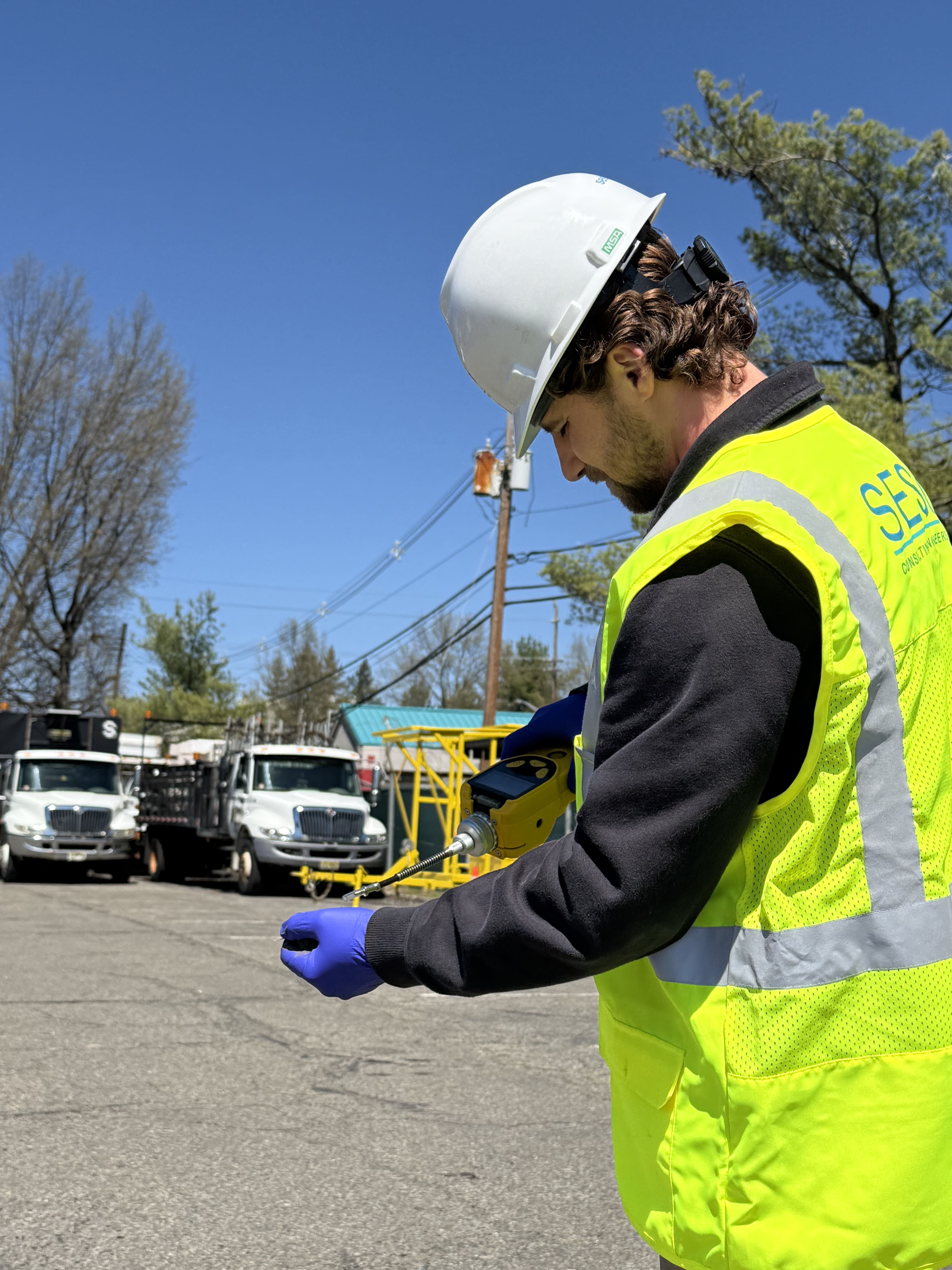SESI is hiring for Geotechnical, Environmental, and Site Civil positions. Apply Now!
Environmental Site Assessments: What You Need to Know
January 20, 2025

Enviornmental Site Assessments (ESAs) are crucial to due diligence in real estate development, land transactions, and construction projects. Whether you are purchasing property, planning to redevelop an industrial site, or investing in commercial real estate, understanding the environmental history and current conditions of a site is essential. Developers and investors risk purchasing contaminated properties without a proper ESA, leading to expensive remediation costs, legal liability, and project delays.
Another key reason ESAs are necessary is regulatory compliance. Many local, state, and federal laws require environmental assessments before construction or development. Failing to conduct an ESA can lead to violations, fines, or restrictions on land use. Additionally, financial institutions often require ESAs before approving loans for property acquisitions or development, as they need assurance that environmental risks are identified and mitigated.
SESI Consulting Engineers specializes in conducting thorough Environmental Site Assessments, helping clients make informed decisions, avoid financial and legal pitfalls, and ensure compliance with regulatory standards. With extensive experience in evaluating land conditions, SESI provides expert guidance through each phase of the ESA process. This blog will explore the importance of ESAs, the phases involved, and why SESI’s approach ensures efficiency, compliance, and cost-effectiveness in property evaluations.
Phase I Environmental Site Assessment: The First Step in Property Due Diligence
Purpose and Scope of a Phase I ESA
A Phase I Environmental Site Assessment (ESA) is the first step in evaluating environmental risks associated with a property. The primary goal of this assessment is to identify Recognized Environmental Conditions (RECs)—indications that a site may be contaminated due to past or present land use. A Phase I ESA is nonintrusive, meaning it does not involve soil or water sampling. Instead, it relies on historical research, on-site inspections, and interviews with property stakeholders to determine the likelihood of contamination.
A Phase I ESA is often required:
- Before purchasing commercial or industrial property
- Before starting a significant redevelopment project
- As part of regulatory compliance for permitting and zoning
- When securing financing from banks or investors
If no environmental concerns are found, the process concludes with a report stating "No Further Action Required." However, a Phase II ESA is typically recommended for further testing if RECs are identified.
Step 1: Historical Research and Data Collection
One of the most critical components of a Phase I ESA is reviewing historical records to determine the site's and surrounding properties' past use. This helps environmental professionals assess whether previous activities may have led to contamination.
- Key records reviewed during this step include:
- Title and Deed Records – To track past ownership and any land-use environmental restrictions.
- Aerial Photographs and Historical Maps – Used to determine prior land uses, including industrial operations, fuel storage, or waste disposal.
- Regulatory Compliance Records – Reviewing federal and state databases for past violations, environmental cleanup orders, or contamination incidents.
- Fire Insurance Maps and Building Permits – Providing insight into past building use, construction materials, and hazardous material storage.
- Local Government and Zoning Records – Examining previous land use approvals and environmental impact assessments.
Step 2: Site Inspection and Stakeholder Interviews
A physical site inspection is conducted to identify any visible environmental concerns, such as:
- Underground Storage Tanks (USTs) or Above-Ground Storage Tanks (ASTs) – Leaking fuel or hazardous waste storage.
- Soil Discoloration or Staining – Possible indicators of chemical spills.
- Chemical Storage Areas and Industrial Waste Disposal – Evaluating whether past or current site operations pose contamination risks.
- Proximity to Contaminated Sites – Determining if nearby properties have experienced environmental contamination that could impact the site.
Environmental professionals also interview property owners, past tenants, and regulatory officials to gather insights on previous site use. If no ecological concerns are found, the Phase I ESA is completed, and the property is considered environmentally viable for development. However, a Phase II ESA is recommended if potential contamination is identified.
Phase II Environmental Site Assessment: Investigating Contamination Risks
The Purpose of a Phase II ESA
A Phase II Environmental Site Assessment is conducted when a Phase I ESA identifies Recognized Environmental Conditions (RECs) that warrant further investigation. Unlike Phase I, this phase involves intrusive testing, such as soil, groundwater, and air sampling, to determine the presence and concentration of hazardous substances.
Phase II ESAs are critical for:
- Confirming or dismissing contamination concerns
- Assessing risks to human health and the environment
- Providing data for remediation planning
If contamination is detected, the results inform the necessary cleanup steps, ensuring compliance with environmental regulations before development proceeds.
Step 1: Soil and Groundwater Testing
Field teams conduct soil and groundwater sampling to assess contamination levels. This process involves:
- Drilling Test Borings – Collecting soil samples at various depths to check for pollutants.
- Installing Groundwater Monitoring Wells – Testing for contaminants that may have seeped into underground water sources.
- Vapor Intrusion Testing – Evaluating whether hazardous gases from contaminated soil or groundwater could pose indoor air quality risks.
Common pollutants tested for include:
- Petroleum hydrocarbons (from fuel storage or spills).
- Heavy metals (such as lead, arsenic, and mercury).
- Chlorinated solvents (often used in dry-cleaning and industrial processes).
- Volatile Organic Compounds (VOCs) (found in industrial chemicals and paints).
Step 2: Laboratory Analysis and Risk Assessment
Once collected, samples are analyzed in a laboratory to determine if contamination levels exceed regulatory limits. Environmental professionals develop a remediation strategy to mitigate risks if pollutants are detected. No further action may be required if contamination is minor or below hazardous thresholds.
Phase III: Site Remediation and Compliance Strategies
Developing a Site Remediation Plan
If a Phase II ESA confirms contamination, a Phase III ESA focuses on developing remediation strategies to clean up the site. Remediation efforts may include:
- Soil Excavation and Replacement – Remove contaminated soil and replace it with clean fill.
- Chemical Treatment and Bioremediation – Using biological agents or chemicals to break down hazardous substances.
- Groundwater Pump-and-Treat Systems – Extracting and filtering contaminated water.
- Vapor Intrusion Mitigation – Installing barriers to prevent harmful gases from affecting indoor environments.
Regulatory Coordination and Long-Term Compliance
Ensuring compliance with environmental laws requires working closely with regulatory agencies. SESI Consulting helps clients navigate permits, approvals, and reporting requirements to maintain compliance throughout the remediation process.
- Post-remediation properties may require ongoing monitoring, including:
- Periodic groundwater and soil testing
- Institutional controls such as land-use restrictions
- Engineering controls such as protective capping of contaminated areas
Why ESAs Are Critical for Long-Term Development Success
Minimizing Financial and Legal Risks
Skipping an ESA can result in severe financial and legal consequences, including:
- Unexpected cleanup costs can derail project budgets.
- Regulatory fines and legal action for failing to comply with environmental laws.
- Decreased property value due to contamination risks.
Ensuring Safe and Sustainable Land Use
Developers must consider regulatory compliance and the long-term impact of environmental contamination on communities and ecosystems. Proper ESAs contribute to responsible land development by:
- Preventing exposure to hazardous substances.
- Protecting groundwater and soil quality.
- Ensuring project feasibility and long-term environmental stability.
Conclusion
Environmental Site Assessments (ESAs) are critical to real estate and development due diligence. A Phase I ESA identifies risks, a Phase II ESA confirms contamination, and a Phase III ESA outlines remediation strategies. These assessments protect investments, ensure compliance, and contribute to responsible land development.
SESI Consulting Engineers
SESI Consulting Engineers offers expert ESA services tailored to project needs, ensuring efficiency, cost-effectiveness, and regulatory compliance.
Contact SESI Consulting today to schedule a consultation and ensure your project is environmentally sound. Visit SESI’s website for more information.




